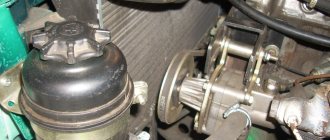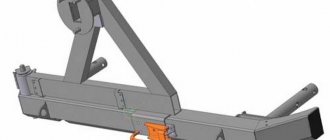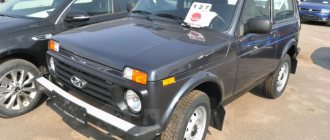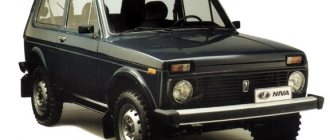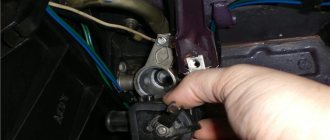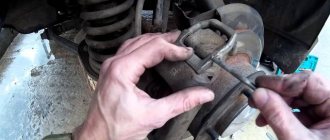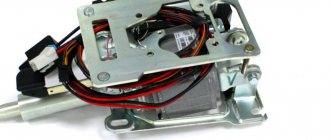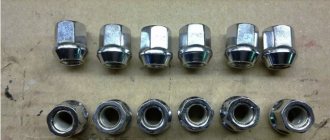*For vehicles with a fuel injection system with a catalytic converter and an oxygen concentration sensor. **Recommended application temperature range: 0W-30 below -35 o C...+25 o C 0W-40 below -35 o C...+30 o C 5W-30 -30 o C...+25 o C 5W-40 -30 o C...+35 o C 10W-30 -25 o C...+25 o C 10W-40 -25 o C...+35 o C 15W-40 -20 o C...+45 o C 20W-50 -15 o C ...above +45 o C ***Recommended application temperature range: 75W-80 -40 o C...+35 o C 75W-85 -40 o C...+35 o C 75W-90 -40 o C...+45 o C 80W-85 -26 o C...+35 o C 80W-90 -26 o C...+45 o C 85W-90 -12 o C...+45 o C and above
The text was scanned by Alex-Niva, processed by ALER, and supplemented by Katzyn.
Regarding the oil volume in the gearbox, the manual erroneously states 1.35 liters (in fact it should be 1.6 liters). It is recommended to fill 100-200 more grams (1.7. 1.8 l). To fill a larger volume of oil than the filler hole, the machine can be tilted to the right. Or you can simply “spit” excess oil into the filler hole, quickly plug it with your finger and screw on the plug.
Changing the oil in the transfer case Niva 21214
The Niva 21214 car is distinguished by its increased cross-country ability on roads. The car has an engine that has a volume of 1.7 liters, which complies with Euro-4 standards. The transmission system includes a transfer case with a crankcase ventilation system. All components on the VAZ 21214, just like on the VAZ 21213, are characterized by a long service life. It is important to take proper care of the automotive system and select high-quality oil for the Niva.
The Niva SUV (VAZ 2121), which has all-wheel drive and is equipped with a manual transmission, is capable of producing 75 horsepower.
Selecting gearbox oil
Which oil to choose? Transmission oils come in a wide range. You should pay attention to fuel that has the following viscosity: 75W-90, 85W-90. In particular, you can choose Lukoil 80W90 gear oil (GL5 class). When operating vehicles in winter, you should purchase 70W-90 oil, as it has a low viscosity. Semi-synthetic options are also suitable for refueling Niva 21213. It is better to carry out replacement at a specialized service center.
How much oil to fill? Approximately 0.8 liters of oil must be added to the Niva distributor. 1.6 liters of transmission fluid is poured into its high-speed box.
Before choosing a transmission fluid, you should always carefully study its composition.
The need to change transmission oil
To change the oil on a Niva, the car must be warmed up (to ensure good fluid fluidity). The machine is placed on an inspection hole; a special container should be placed under the drain hole into which the waste liquid will drain. To open the drain and fill plug, you should use a hexagon. Also, as an additional tool, you will need a special syringe, which is used to fill the transfer case with fuel.
Changing the oil in the transfer case (Niva 21214 / 21213). Main stages:
- The drain plug is unscrewed.
- The remaining oil is poured into the container.
- Any contamination on the plug must be eliminated.
- The drain plug is screwed in.
- The top plug is unscrewed to fill in new oil using a syringe.
- The plug is screwed in.
The peculiarity of the gearbox is that it has a built-in magnet. Its function is to attract small metal debris that may be present in the fuel.
When replacing fuel, the crankcase must be flushed. This procedure helps to extend the operational life of the box. Flushing is required if the drained oil is heavily contaminated.
The frequency of changing fuel for the transmission is affected by the mileage of the Niva 21214 (21213) and the conditions under which it is used. When making frequent off-road trips, the need to change the oil for the transfer case and gearbox may arise up to 50,000 km.
The need to add a new lubricant to the box can be indicated by the fact that the gearbox began to overheat and characteristic noises appeared on its side during movement.
Design Features
Initially, the 21214 engine was developed for distributed injection, that is, for an injector. It was planned to ensure an environmentally friendly standard, which was carried out successfully - during the finalization process, the internal combustion engines had Euro-2 - Euro-4, and for the export versions of Niva and Nadezhda, even Euro-5.
The main feature of 21214 was the factory boost:
- injector instead of carburetor;
- modified cylinder head (hydraulic pushers);
Hydraulic support ramp (bottom)
In turn, this required improvement of other designs:
- the volume of engine oil has increased, the pump sprocket now has 30 teeth to increase its performance;
- the double-row chain is replaced by a roller-type single-row modification to drive attachments and the timing camshaft;
- The camshaft cams have changed shape.
Design 21214
Upgraded chain tension system:
- the spring creates pre-tension when the engine is off;
- After starting, pressure is created in the system, the tension is regulated by hydraulics.
Hydromechanical chain tensioner
The manufacturer has provided additional do-it-yourself tuning due to the +50 hp potential built into the design. With. Overhauling the simplest internal combustion engine design does not cause any problems, including in a garage on your own.
Bosch 0280158110 injectors were first installed on the fuel rail, then yellow Siemens VAZ 20734. The ignition has a modular design with Bosch MP 7.9.7 and January 7.2 controllers. Pair-parallel injection provides Euro-2, phased injection – Euro-3.
Filling volumes for a VAZ 21214 car
It’s one thing to buy a car, and another to know and understand what to do with it: what to protect it from, when to “feed” it, how to operate it. No matter what kind of car you own, sooner or later you will need to refuel it. Today we will talk about the filling volumes of the VAZ 21214 and what to fill where.
First of all, let's talk about the fuel tank. Its volume in the VAZ 21214 is 42 liters (including reserve). Fill with gasoline with an octane rating of 91 to 93.
The fuel supply system is necessary to power the car engine, as well as its cleaning and storage.
The volume of the cooling system is 10.7 liters, which also includes the interior heating system. Fill in coolant whose freezing point is not higher than minus 40°C.
Cooling system - devices that provide supply of cooling medium to heated engine parts and removal of excess heat, i.e. maintaining the engine within the required thermal limits.
Engine lubrication system - 3.75 liters. It is necessary to select a specific oil, depending on the ambient temperature.
-20°С +40°С SAE 15W-40
-25°С +45°С SAE 10W-40
-30°С +45°С SAE 5W-40
-25°С +35°С SAE 10W-30
-30°С +35°С SAE 5W-30
The main task of the lubrication system is to reduce friction of mating parts. It also provides cooling of engine parts, protection against corrosion, removal of wear products and carbon deposits.
The filling volume of the gearbox housing is 1.35 liters, the transfer case housing is 0.75 liters, and the front axle housing is 1.15 liters. and rear axle housing 1.3 l. To fill these units, gear oils with a quality level corresponding to API GL-5 and a viscosity of 75W-90 are suitable.
The steering gear housing has a volume of 0.18 liters. You can add 75W-90 gear oil here.
The hydraulic brake system (0.515 liters) and clutch release system (0.2 liters) will require DOT-4, -3 brake fluid, respectively.
The volume of the windshield washer and rear door glass washer reservoir is 2 liters. You can fill it with either regular water or a mixture of water and windshield washer.
Power unit
The engine installed on the modern model of the Niva 21213 (214) car was inherited from its Soviet progenitor - the VAZ 2121, and in terms of fluid volumes they are almost identical:
- Liquid cooling system. Filled with antifreeze in an amount of 10.7 liters with a freezing point not higher than -40 ° C. The capacity of the interior heating radiator is also included in this volume.
- Crankcase. Motor oils are poured here, the brand of which depends on the operating conditions. Capacity: 3.75 liters, including oil filter filling.
The viscosity of the oil poured into the Niva engine must correspond to the outdoor temperature at which the car is operated. Possible modes and suitable oil brands are shown in the table:
| Lower limit of ambient temperature, °C | -20 | -25 | -25 | -30 | -30 | -15 | -35 | -30 |
| Upper limit of ambient temperature, °C | +45 | +35 | +45 | +35 | +45 | +45 | +25 | 30 |
| SAE lubricant viscosity grade | 15W-40 | 10W-30 | 10W-40 | 5W-30 | 5W-40 | 20W-40 | 0W-30 | 0W-40 |
When flushing the power unit during the process of replacing liquid lubricant, the same amount of flushing oil (3.75 l) is used, taking into account the size of the filter. Replacement is carried out after 8-12 thousand kilometers, depending on the quality of the oil. Flushing is usually performed after 3 engine lubricant changes. During operation, it is important to monitor the oil level in the engine crankcase using a special dipstick. If the level drops below the Min mark, it is urgent to add lubricant to the engine of the same viscosity as was previously filled.
Antifreeze needs to be updated at least once every 3 years or according to the degree of wear of the fluid. It is not recommended to dilute antifreeze with distilled water, either in winter or summer. In winter, the diluted liquid may freeze, and during the summer heat it may boil ahead of time, which will lead to overheating of the engine.
Changing the oil in the Niva 21213, 2121 gearbox
According to the recommendations of the VAZ manufacturer, the oil level should be checked after every forty to sixty thousand kilometers, but practice shows that it is better to do this at least twice as often. If, during inspection, you find that the oil is dirty and smells of burning, this means that it needs to be changed immediately. This procedure is easy to carry out yourself. Changing the oil in Niva 21213 is done in exactly the same way as in 2121.
Changing the oil in the gearbox.
The entire operation must be carried out in the inspection hole, and before the operation you need to drive eight to ten km so that the oil warms up.
If you are changing the oil for the first time, the first thing you need to do is find the filler neck. It is located on the left side and may not be immediately noticeable due to the gimbal. Do not confuse it with the technological plug, which is located on the right.
Having found the neck, take a 12mm hex and unscrew the drain plug.
Place a container near the neck and let the oil drain.
Next, clean the plug magnet from dirt and metal particles and screw the plug back on.
Now take the 17 key and unscrew the filler plug.
Then, using a special syringe, fill the oil to the bottom edge of the hole and tighten the plug.
All.
By the way, sometimes it happens that the box becomes clogged with metal shavings or the seals begin to leak. In such cases, you just need to add oil.
| Refillable system | Volume, l |
| Fuel tank (including reserve) | 42 (65*) |
| Engine cooling system (including interior heating system) | 10,7 |
| Engine lubrication system (including oil filter) | 3,75 |
| Gearbox housing | 1,6 |
| Rear axle housing | 1,3 |
| Steering gear housing | 0,18 |
| Transfer case housing | 0,79 |
| Front axle housing | 1,15 |
| Hydraulic clutch system | 0,2 |
| Hydraulic brake system | 0,535 |
| Windshield and headlight washer reservoir | 2,8 |
| Rear window washer reservoir | 2,0 |
| Power steering reservoir | 1,7 |
* For VAZ-2131 cars and its modifications.
Refueling or lubrication point
Quantity, l
Name of materials
Motor gasoline with octane number 91–93, 95*
Engine cooling system including interior heating system
Coolant with a freezing point no higher than –40°C
Engine lubrication system, including oil filter, at ambient temperature:
Motor oils (with API quality level: SG, SH, SJ)
Gearbox housing
Gear oils with quality level according to API GL-5 and viscosity 75W-90
Transfer case housing
Front axle housing
Rear axle housing
Steering gear housing
Tank characteristics
The fuel tank of this model has almost sixty liters, or more precisely - 58. On average, per hundred kilometers you have to spend 8-9 liters of AI-95, Premium-95 or AI-92 gasoline.
- The tank is located directly under the rear seat.
- In the upper part there is a small hatch under which the fuel pump is installed.
- The sensor will help determine the level of fuel fluid and the amount of gasoline.
There are other Chevrolet Niva filling tanks, many of which are included in various systems.
Motor oils
| Oil brand | SAE viscosity grade | Group | Manufacturer | Regulatory document | |
| AAI | AP1 | ||||
| LUKOIL LUX | 5W-30, 5W-40 10W-40,15W-40 | B5/D3 | SJ/CF | LLC "Lukoil-Permnefteorg-sintez", Perm | STO 00044434-003 |
| LUKOIL LUX | 0W-40, 5W-20, 5W-30, 5W-50, 10W-30 | B5/D3 | SL/CF | LLC "Lukoil-Permnefteorg-sintez", Perm | STO 00044434-003 |
| TNK SUPER | 5W-30, 5W-40 10W-40 | B5/D3 | SJ/SL/CF | TNK Lubricants LLC, Ryazan | TU 0253-008-44918199 |
| TNK MAGNUM | 5W-30, 5W-40 10W-40,15W-40 | B5/D3 | SJ/SL/CF | TNK Lubricants LLC, Ryazan | TU 0253-025-44918199 |
| ROSNEFT MAXIMUM | 5W-40, 10W-40 | B5/D3 | SL/CF | OJSC "Novokuibyshevsk Oil and Additives Plant", Novokuibyshevsk | TU 0253-063-48120848 |
| ROSNEFT OPTIMUM | 10W-30, 10W-40 15W-40 | B5/D3 | SJ/CF | OJSC "Novokuibyshevsk Oil and Additives Plant", Novokuibyshevsk | TU 0253-062-48120848 |
| ROSNEFT MAXIMUM | 5W-40, 10W-40 | B5/D3 | SL/CF | OJSC "Angarsk Petrochemical Company", Angarsk | TU 0253-391-05742746 |
| ROSNEFT OPTIMUM | 10W-30, 10W-40 15W-40 | B5/D3 | SJ/CF | OJSC "Angarsk Petrochemical Company", Angarsk | TU 0253-389-05742746 |
| ROSNEFT PREMIUM | 0W-40, 5W-40 5W-40 | B5/D3 | SJ/CF SL/CF SM/CF | OJSC "Angarsk Petrochemical Company", Angarsk | TU 0253-390-05742746 |
Continuation of the table. 2
| Oil brand | SAE viscosity grade | Group | Manufacturer | Regulatory document | |
| AAI | API | ||||
| EXTRA 1 EXTRA 5 EXTRA 7 | 5W-30 15W-40 20W-50 | B5/D3 | SJ/CF | OJSC "Omsk Oil Refinery", Omsk | TU 38.301-19-137 |
| EXTRA | 5W-30, 10W-40, 15W-40 | B5/D3 | SL/CF | OJSC "Omsk Oil Refinery", Omsk | TU 38.301-19-137 |
| ESSO ULTRA | 10W-40 | B5/D3 | SJ/SL/CF | Exxon-Mobil, Germany | |
| GTTURBO SM | 10W-40 | B5 | S.M. | Hanval INC, Korea | |
| LIQUI MOLY OPTIMAL | 10W-40 | B5/D3 | SL/CF | Liqui Moly GmbH, Germany | |
| MOBIL 1 MOBIL SYNT S MOBIL SUPER S | 0W-40, 5W-50 5W-40 10W-40 | B5/D3 | SJ/SL SM/CF SJ/SL/CF | Exxon-Mobil, Germany | |
| MOBIL 1 ESP FORMULA | 5W-30 | B6/D3 | SJ/SL SM/CF | ||
| RAVENOL HPS RAVENOL VSI RAVENOL LLO RAVENOL TSI RAVENOL Turbo-C HD-C | 5W-30 5W-40 10W-40 10W-40 15W-40 | B5/D3 | SL/CF SL/CF SL/CF SL/CF SJ/CF | Ravensberger Schmirstoffvertrieb GmbH, Germany | |
| SHELL HELIX: PLUS PLUS EXTRA ULTRA | 10W-40 5W-40 5W-40 | B5/D3 | SL/CF | SHELL EAST EUROPE Co, UK, Finland | |
| ZIC A PLUS | 5W-30, 10W-30, 10W-40 | B5 | SL | SK CORPORATION, Korea | |
Note. The oil change period is in accordance with the vehicle service book.
RECOMMENDED TEMPERATURE RANGES FOR APPLICATION OF MOTOR OILS
| Minimum engine cold start temperature, 0C | Viscosity grade according to SAE J 300 | Maximum ambient temperature, 0C |
| below -35 | 0W-30 | 25 |
| below -35 | 0W-40 | 30 |
| -30 | 5W-30 | 25 |
| -30 | 5W-40 | 35 |
| -25 | 10W-30 | 25 |
| -25 | 10W-40 | 35 |
| -20 | 15W-40 | 45 |
| -15 | 20W-40 | 45 |
Maintenance
The manufacturer AvtoVAZ recommends servicing the 21214 engine on your own or at a service station according to the following schedule:
- the oil and filter are updated annually or after 7.5 - 10 thousand mileage;
- the chain has a high resource of 200 thousand, but is regularly monitored for stretching/tension;
- the fuel and air filters become unusable after 20 - 30 thousand mileage;
- spark plugs and batteries are usually enough for 60 - 70 thousand km;
- It is recommended to update the cabin filter annually, regardless of the car's mileage.
Initially, the internal combustion engine design was simpler, but it was necessary to periodically adjust the erroneous settings of the valve thermal clearances. Then the modernization added hydraulic pushers to the timing belt design, saving the user from this operation and monthly expenses.
Flushing fluids for the engine lubrication system
Liquid brand
Manufacturer
Regulatory document
OJSC Lukoil-Nizhegorodnefteorgsintez, Kstovo, LLC Lukoil-Permnefteorgsintez, Perm
OJSC Novo-Ufa Oil Refinery, Ufa
OAO Angarsk Petrochemical Company, Angarsk
MP SYNTHETIC MP CLASSIC
OJSC "Omsk Oil Refinery", Omsk
Note. Flushing fluids are used during maintenance in accordance with the service book when replacing the working engine oil with fresh one.
What cars was it used in?
Motor 21214 was used to equip several cars manufactured by AvtoVAZ:
- Lada Niva 4x4 (VAZ-21214) – three-door SUV;
- Lada 4x4 M - modernized version with power steering and ABS;
- Lada 4x4 5D (VAZ-213100) – an extended modification of a five-door SUV;
- “Ambulance” (VAZ-213145) – Euro-2/3 in small series;
- Lada Nadezhda (VAZ-2120) is a seven-seater all-wheel drive minivan.
Niva Lynx 4x4
The management did not consider it necessary to install it on the seven-seater Largus minivan. But in all modifications of the Niva 3- and 5-door (Bronto, Kedr, Pickup, Reka, Bys and armored collection vehicle) it was present.
Tuning
The manufacturer used only one technique to increase engine power - increasing the piston stroke. Self-tuning will help you modify the 21214 engine to use its full potential (about 90 hp):
- boring of cylinders in the block - scheme 84/84 or 84/88 to obtain 1.9 liters and 2.0 liters (cylinder diameter/piston stroke, respectively);
- modification of the cylinder head - boring of channels up to 31 mm (exhaust) and 33 mm (intake), installation of a lightweight SHPG flywheel, Nuzhdin camshaft.
Thus, the injection version 21214 is superior to the basic modification of the carburetor engine. It has increased torque and power, and bends the valves with pistons when the single-row chain wears out.
If you have any questions, leave them in the comments below the article. We or our visitors will be happy to answer them
History of the machine
Lada 4×4 2131 Niva 2006
It all started back in 1970, when Chairman of the Council of Ministers of the USSR Alexei Kosygin, as part of the program “blurring the line between city and countryside,” set the teams of VAZ, AZLK and Izhmash the task of creating a comfortable SUV for residents of rural areas.
The first experimental VAZ-E2121 saw the light of day in 1971. Moreover, his appearance was very far from what we have become accustomed to for forty years. In fact, it was a chassis with a simple tail, on which the concept of a new car was developed - the SUV did not have a frame, which at that time was considered an unheard-of design audacity. Initially, the car was planned to be equipped with a powerful diesel engine, final drives, rear torsion bar suspension and even a tire pressure regulation system, but later they decided to create a simpler version with a high degree of unification with the models already produced by AvtoVAZ, which was economically justified. This prototype allowed the design bureau under the leadership of Peter Prusov to significantly reduce the time needed to create the car.
The VAZ-2121 appeared in a form close to the serial one in 1972. The artist Valery Semushkin worked on the design of the new car. The car, according to the designer, was supposed to suit residents of both cities and villages.
In 1974, the car was put up for state tests and in the same year received its own name “Niva”, which was patented.
In addition to sales at home, Niva was actively promoted in foreign markets. Over forty years, more than 500 thousand SUVs were sent abroad. This unpretentious, but at the same time quite comfortable SUV has attracted buyers in more than 100 countries around the world. Importers actively re-equipped the car, making it into pickup trucks, convertibles, and styling it according to fashion. In addition, assembly of the model was established in Brazil, Greece, Canada, Panama, Chile, and Ecuador.
In 1978, the VAZ-2121 was awarded a gold medal and recognized as the best car of its class at the international exhibition in Brno. “Niva” has a lot of records.
So, in 1998, Niva climbed Mount Everest under its own power, to a height of 5200 meters, in the same year, being dropped by parachute, it ended up in the Arctic and reached the North Pole under its own power, and the next year climbed to the Himalayas to a height of 7260 meters. She also visited Fuji. The reliability of the car is also evidenced by the fact that the production car was able to operate without serious breakdowns for 15 years in Antarctica at the Bellingshausen station.
In 2001, the history of the VAZ-2121 as a Niva ended. The holder of the exclusive license for the Niva trademark was the GM-AvtoVAZ joint venture. But the history of the car itself continued and continues under the name LADA 4X4.
Greases
| Lubricant brand | Manufacturer | Regulatory document |
| Vaseline technical VTV-1 | JSC "Rikos", Rostov-on-Don | TU 38.301-40-21 |
| Vaseline technical ONMZ VTV-1 | JSC "Neftemaslozavod", Orenburg | TU 0255-195-05767887 |
| Lubricant AZMOL GRAPHITOL | OJSC "Azmol", Berdyansk | TU U 23.2-00152365-178 |
| LIMOL lubricant | OJSC "Azmol", Berdyansk | TU 38.301-48-54 |
| LITA grease | OJSC "Azmol", Berdyansk | TU 38.101-1308 |
| LITOL-24 lubricant | OJSC "Azmol", Berdyansk | GOST 21150 |
| Grease AZMOL LSC-15 | OJSC "Azmol", Berdyansk | TU U 23.2-00152365-180 |
| UNIROL-1 grease | JSC "Rikos", Rostov-on-Don | TU 38.301-40-23 |
| Grease UNIOL-2M/1 | OJSC "Azmol", Berdyansk | TU 38.5901243 |
| Grease AZMOL FIOL-1 | OJSC "Azmol", Berdyansk | TU U 23.2-00152365-173 |
| Grease AZMOL ShRB-4 | OJSC "Azmol", Berdyansk | TU U 23.2-00152365-172 |
| Lubricant AZMOL SHRUS-4 | OJSC "Azmol", Berdyansk | TU U 23.2-00152365-182 |
| CV joint grease-4M | OJSC "Perm Plant of Lubricants and Coolants", Perm | TU 38.401-58-128 |
| Ortol Sh lubricant | JSC "Neftemaslozavod", Orenburg | TU 0254-001-05767887 |
| Grease CIATIM-201 | OJSC "Azmol", Berdyansk, OJSC "Rikos", Rostov-on-Don, LLC NPF "RUSMA", St. Petersburg, OJSC "Neftemaslozavod", Orenburg | GOST 6267 |
| Grease CIATIM-221 | OJSC "Azmol", Berdyansk, OJSC "Rikos", Rostov-on-Don, LLC NPF "RUSMA", St. Petersburg | GOST 9433 |
Continuation of the table. 9
| Lubricant brand | Manufacturer | Regulatory document |
| Solid lubricant Molybdol M3 | CJSC "Technology", St. Petersburg | TU 301-02-63 |
| Lubricating graphite “P” | OJSC "Azmol", Berdyansk | GOST 8295 |
| Ditor lubricant | JSC "Rikos", Rostov-on-Don | TU 0254-007-05766706 |
| CASTROL S-058 grease | , Germany | TTM 1.97.733 |
| MOLYKOTE X-106 grease | , USA | TTM 1.97.0115 |
| Renolit JP 1619 grease | , Germany | TTM 1.97.0800 |
| Lubricant Lucas PFG-111 | , Germany | TTM 1.97.0733 |
Malfunctions, causes, elimination
Initially, engine 21214 has a characteristic failure - failure of 1 - 2 cylinders due to failure of the ignition module due to overheating. The coils and control switch burn out, and electrical equipment needs to be replaced. Other breakdowns are typical for most VAZ engines:
| At idle, the internal combustion engine is unstable and stalls. | 1) damage to the insulation of high-voltage wires 2) spark plug malfunction 3) valve timing failure 4) compression decreased | 1)replacement of high-voltage beams 2)adjusting the interelectrode gap, cleaning carbon deposits 3) installation according to shaft marks 4) valve grinding, cylinder repair |
| XX speed decreased spontaneously | 1) production of DXX | 1) replacing the idle speed sensor |
| The engine stalls while driving in the heat | 1) check valve stuck 2) the hose or tube is pinched 3) the drain line has failed 4) steam plug in the supply system | 1) valve replacement 2) inspection and correction of geometry 3) purging the line 4) purge and cleaning |
Hydraulic compensators eliminate the need for scheduled adjustment of valve clearances after 5–15 thousand kilometers.
Fuel and drain line
Leaks and problems
The higher the mileage of the VAZ Niva, the more problems appear, as in principle with any car. Most often this is due to natural wear and tear of the engine, causing oil to burn. Although the manufacturer allows for a small consumption.
There can be many reasons why an engine eats oil. And in each case they can be individual. But, over the years of the model’s existence, we can talk about the most common places where leaks occur.
If the breather is spewing or throwing oil, or if there is oil in the exhaust manifold, this may indicate a serious problem with the oil rings. In this case, you can try decoking with dimexide. But it is better to use special auto chemicals designed for these purposes.
A leak from under the valve cover may be due to a worn gasket. Sometimes simply replacing the gasket does not solve the problem. Since the cover itself may have significant curvature. Therefore, in some cases it will have to be replaced.
A white emulsion in the engine or on the oil filler cap may indicate condensation. This is a common occurrence when temperatures change from minus to plus, mainly in autumn or spring.
But if the emulsion is also observed on the dipstick, then this is already a sign of more serious problems. Most often we can talk about a broken cylinder block gasket. And in rare cases, a cracked cylinder head may be to blame.
Also, with this problem, you can find oil in the expansion tank. Sometimes, simply replacing the gasket is not enough. It may be necessary to grind the head itself, and this is completely different money for repairs.
All this is general information, which may manifest itself differently on each specific vehicle, since everyone’s operating modes are different. The same applies to leak locations; it is impossible to identify the cause from a distance.
Synthetic or mineral water?
There is also quite a lot of controversy on this topic. Many say that even with a mineral engine they can maintain more than 200,000 km without major engine repairs. And there is truth in this. I personally know and was familiar with cars, many years ago, that covered 350 thousand km. without capital on mineral water.
Of course, it would be stupid to compare the quality of the USSR and today's, since there are now more fakes in some retail outlets than real goods. But one thing is for sure: if you use semi- or full synthetics, the engine life will be longer. Comfort during winter operation will increase, especially when starting and warming up the engine. And the engine can withstand more severe temperature loads on synthetic oil than on mineral oil.
Now it's worth talking about the transmission. First, let's also look at the table.
